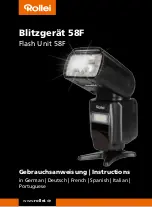
12
c
CRANE connector (12-pin)
For external interface, such as viewfinder and external data.
d
USB connector (for connecting a USB drive)
Connect a USB drive to save or load the settings data file.
For details, see “Using a USB Drive” on page 61.
e
TRACKER connector (10-pin)
For external interface, such as intercom and tally.
f
RET CTRL (return control) connector (6-pin)
For connection to a CAC-6 Return Video Selector.
g
DC IN (DC power supply input) connector (XLR 4-pin)
Used for connection to the AC-DN10 AC Adaptor to supply
power to the camera.
h
INTERCOM1 and 2 (intercom 1 and 2) connectors (XLR
5-pin)
Used for input and output of intercom audio signals if an XLR
5-pin headset is connected.
The INTERCOM 1 connector can be used for communication
over the engineer line even when the power is off, as long as
the power LED is lit in red.
i
REMOTE connector (8-pin)
For connection to an RCP-1000/1500-series Remote Control
Panel, or MSU-1000/1500 Master Setup Unit.
Note
When the camera is connected to a camera control unit, do not
connect any remote control device, such as RCP and MSU, to
this connector.
j
PROMPTER/GENLOCK (prompter signal output/
external genlock signal input) connector (BNC-type)
The PROMPTER function is available only when a camera
control unit is connected. The GENLOCK IN function and RET
IN function are available when a camera control unit is not
connected.
GENLOCK IN:
For input of an external genlock signal (VBS or
3-level sync) during standalone operation.
RET IN:
For input of the return video signal during standalone
operation.
The connector accepts analog HD signals only. SDI
signals cannot be input. Supply a signal of 1080i (720P
cannot be input).
The signal supplied to this connector cannot be fed as
RET OUT from the TEST OUT or SDI OUT connector.
This is displayed in the viewfinder regardless of which
RET is selected. CHARACTER will not be overlapped for
the displayed RET 3 signal.
PROMPTER:
For output of the prompter 1 signal (valid only
when a camera control unit is connected). When a
camera control unit having two prompter inputs is
connected, the signal of input 1 is output from this
connector.
k
TEST OUT connector (BNC-type)
To output the analog signal.
This also supplies the VBS signal, an HD signal nearly equal
to the signal output from the VF connector, an HD-SYNC
signal, or an SD-SYNC signal depending on which of these
you have selected on the menu.
For details about signal settings, see “Setting the Camera
Outputs” on page 24.
l
SDI-MONI (serial digital interface) connector
(BNC-type)
For HD-SDI or SD-SDI signal output.
For details about signal settings, see “Setting the Camera
Outputs” on page 24.
m
AUDIO IN CH1 and CH2 connectors (XLR 3-pin) and
switches
Connect audio signals. An input select switch and microphone
power switch are provided for each channel.
CH1 audio input select switch
Set to the appropriate position according to the equipment
connected to the AUDIO IN CH1 connector.
LINE:
When a line-level (0 dBu) signal source is connected
FRONT MIC:
When using the microphone connected to the
MIC 1 IN connector
MIC:
When an external microphone is connected
CH2 audio input select switch
Set to the appropriate position according to the equipment
connected to the AUDIO IN CH2 connector.
LINE:
When a line-level (0 dBu) signal source is connected
AES/EBU:
When a digital audio signal is connected (The
signal must be in synchronization with the camera
output.)
MIC:
When an external microphone is connected
Microphone power switches
When a microphone is connected to the corresponding AUDIO
IN connector, set whether or not to supply a power to the
microphone.
+48V:
To supply a power of +48 V.
OFF:
Not to supply power.
(No function has been assigned to the lowermost position. No
power is supplied to the microphone.)
CH 1
48V
OFF
MIC
LINE
48V
OFF
MIC
LINE
AES/EBU
FRONT MIC
AUDIO IN
CH 2
CH1 audio input select switch
Microphone power switches
CH2 audio input select switch
AUDIO IN CH2 connector
AUDIO IN CH1 connector













































